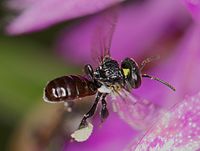
Photo from wikipedia
Adult horn fly populations were tracked on cattle for 2-week periods before, during and after multiple treatments (every 3-4days) with two repellents in a mineral oil carrier. Cattle were sprayed… Click to show full abstract
Adult horn fly populations were tracked on cattle for 2-week periods before, during and after multiple treatments (every 3-4days) with two repellents in a mineral oil carrier. Cattle were sprayed four times in a two-week period either with 2% geraniol (125ml/cow) or a 15% mixture of short chain fatty acids (C8-C9-C10)(250ml/cow), and there were untreated control cattle. Trials were conducted in California and North Carolina for 3 summers. Short-term fly counts (same day) on treated cattle were reduced by 61-99%, depending on material and trial, and the fatty acid mixture provided better control than geraniol. Horn fly counts were suppressed for 1-3 d and rebounded somewhat after both treatments. Consecutive treatments showed evidence of persistent impact in California where herds were more isolated. Rebounds to pre-treatment levels 3-4 d after treatment occurred more often in North Carolina, where other infested cattle were closer to treated herds. By 3-4 d post-treatment, horn flies were reduced by 29-61% in California and 0-83% in North Carolina, relative to pre-treatment. Background behavior frequencies were assessed from hundreds of counts on untreated, infested California cattle, where horn flies were the only abundant biting fly. Behavior averages were 16.5 tail flicks, 7.6 skin twitches, 1.2 head throws, or 0.2 leg stamps per 2min observation period. At horn fly densities from about 200 to more than 1000 flies per animal (moderate to high numbers), fly defensive behaviors on control cattle were poorly related (or unrelated) to fly numbers. Immediately after repellent application, however, flies were almost absent and behavior frequencies dropped distinctly. Cattle fly defensive behaviors therefore seem to be quite sensitive to low (less than 100 flies/animal) horn fly densities, and behaviors would be a poor quantitative tool to track fly stress at moderate densities and above. Both geraniol and the fatty acids show promise for horn fly control, especially in organic agriculture. Treatments at 1-2 d intervals probably would keep infestations below the economic threshold (200 flies/cow).
Journal Title: Veterinary parasitology
Year Published: 2017
Link to full text (if available)
Share on Social Media: Sign Up to like & get
recommendations!